Ortagui
Appearance:
Build:
From slim to muscular to stout.
Height: (cm)
Females: 170-180
Males: 180-190
Weight: (kg)
Females: 55-75
Males: 60-85
Lifespan: (yr)
Females; 150-155
Males: 145-150
Skin:
Dark golden, brown some even black.
Hair:
Mostly brown, black or white.
Eyes:
Any
Language:
- REALMISH
- WESTRIL
- WEST-SKOGISH
- EAST-SKOGISH
- NORTH-SKOGISH
- UPPER-SKOGISH
Culture:
- COASTAL
- DESERT
- GRASSLAND
- HIGHLANDER
- NOBILITY
- NOMAD
- URBAN
- WALDER
Timeline:
Legend
“Their cradle, once vast beautiful farmlands… are now but desolate, and hot burning sands…”
Description
A separate Race known as the Ortagui arises from the vast tapestry of races—people whose presence resonates with the heartbeat of the Country they call home. Given the gift of a brief existence, they wander the regions with a fiery impatience that frequently colours their relationships. The Ortagui stand as a monument to the force of quick action and ferocious resolve within the tapestry of races, their Skills weaved into a heritage that invites respect and adoration.
The Ortagui are characterised by impulsive decision-making and a Spirit that blazes like a ball of fire through the night sky. Their impatience, like the spark before a storm, motivates their desire to achieve greatness and to make their own path despite the ephemeral nature of their lives. These creatures are endowed with the ability to do deeds that make a lasting impression; their tales of grandeur have been passed down through centuries.
The Ortagui cherish their unusual stature—a leaner frame that speaks of endurance sculpted by punishing environments—and are eager to make their mark in the annals of history. Their bodies, hardened by the obstacles they undergo, bear witness to their tenacity and resolve. Their Tribes thrive in the regions of Northern. Midgard, a tribute to the relationship they share with the place they live.
A Culture that connects with the nomadic way of existence calls to the Ortagui, their spirits in sync with nature’s rhythm. They ride the countryside with ease, their bond with their horses unshakable as they cross the wilds with elegance. The scimitar, a symbol of their ancestors, becomes an extension of themselves, a weapon of defence and prowess wielded with dexterity.
While the brevity of their existence may cause others to despair, the Ortagui appreciate the freedom that their restricted time gives. Their dedication to the Deities reflects their pragmatic attitude to life, as they switch between divine allegiances to maximise their profits during their limited lives. Their faith is intertwined into their everyday activities, where they seek the divine’s graces to magnify their efforts.
The Ortagui stand tall—a sign of urgency, tenacity, and determination—in a world where every minute is a gift, where the wind carries whispers of heritage and the land bears the weight of hopes.
The very air appears to vibrate with each stride they take, a monument to their vibrant vitality that transcends time restrictions.
Skjald Vinotis
History

Dark Ages
In 6028, the year of the first Ortagui, an Archaic Cromi group assaulted a T'Aurs camp. The T’Aurs easily repelled the attackers, who were traced back to the Archaic camp, and to send a message of retaliation if attacked, they slaughtered the Archaic guards, raped, and plundered. The outcome was evident months later, and the first T’Aurs and Archaic Cromi kid blinked its eyes almost a year later. More babies soon cried out in unison. As a result of the mating of T’Aurs and Archaic Cromi, a new race arose, and Ortagui, which means “strong willed children,” is the 12th oldest Indigenous race.
Short-lived, strong, and often impulsive or impatient with all other races. Some have won the esteem of the Divine and N-Erectus for their extraordinary feats. They reside in dispersed Clans and are members of bigger tribes. They are powerful despite their significantly lower stature, and their circumstances have toughened them. The T’Aurs instilled in them a desire to explore and learn. They promptly started exploring the ‘Void Gardens’ on several routes. They soon bred with just their own kind, separating themselves from those who had T’Aurs and Archaic, or their half-cousins, with Ortagui as one parent. As a result, their race became even more different from their predecessors, substantially less than T’Aurs but significantly more than Archaic.
They met bands or camps of other Human, or N-Erectus, and even divine creatures on their travels. As a result, Ortagui can tell tales of Gods who were but guiding and consoling forces between radiant or vibrant Mana links long before they turned into the haughty, whimsical Divine beings they are now. At times, some Ortagui stayed at these dynamic or soothing locations, while others departed. As a result, Ortagui has formed a pragmatic relationship with the Divines, favouring Gods Thursar, Wickeryadi, and Boriac based on which could help the most and was willing to teach those who stayed. As Ortagui preferred to roam The Void or World, they never had noteworthy contact with the Vornir.
When the Divine Races took control of everything and built our world, The Ortagui, dispersed across the void in very distinct clans within their tribes, were seized, plucked, picked, swept, and poured upon Midgard’s northern half; thus, tensions rose.
Skjald Ulrich
First Age
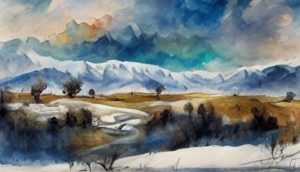
Tumult and darkness, no glowing mana links to follow, no distant sparkling leaks to guide them. Only what the few Mana Manipulators could conjure shed light on the world’s shaping. The bending of the ground shocked them. So they prayed, sacrificed, and turned to Thursar and Wickeryadi for help in the utter darkness. Their prayers were answered as two powerful Thursars, of Fire and Ice, accepted the other Divines’ invitation to be forever infused with all energies and glide in archways outside the world. Bringing night and day, warmth and cold with them. The Ortagui cheered as the Thursar changed into the Sun and Moon. They have been supporting Thursar ever since.
Skjald El Mary
Midgard’s domains
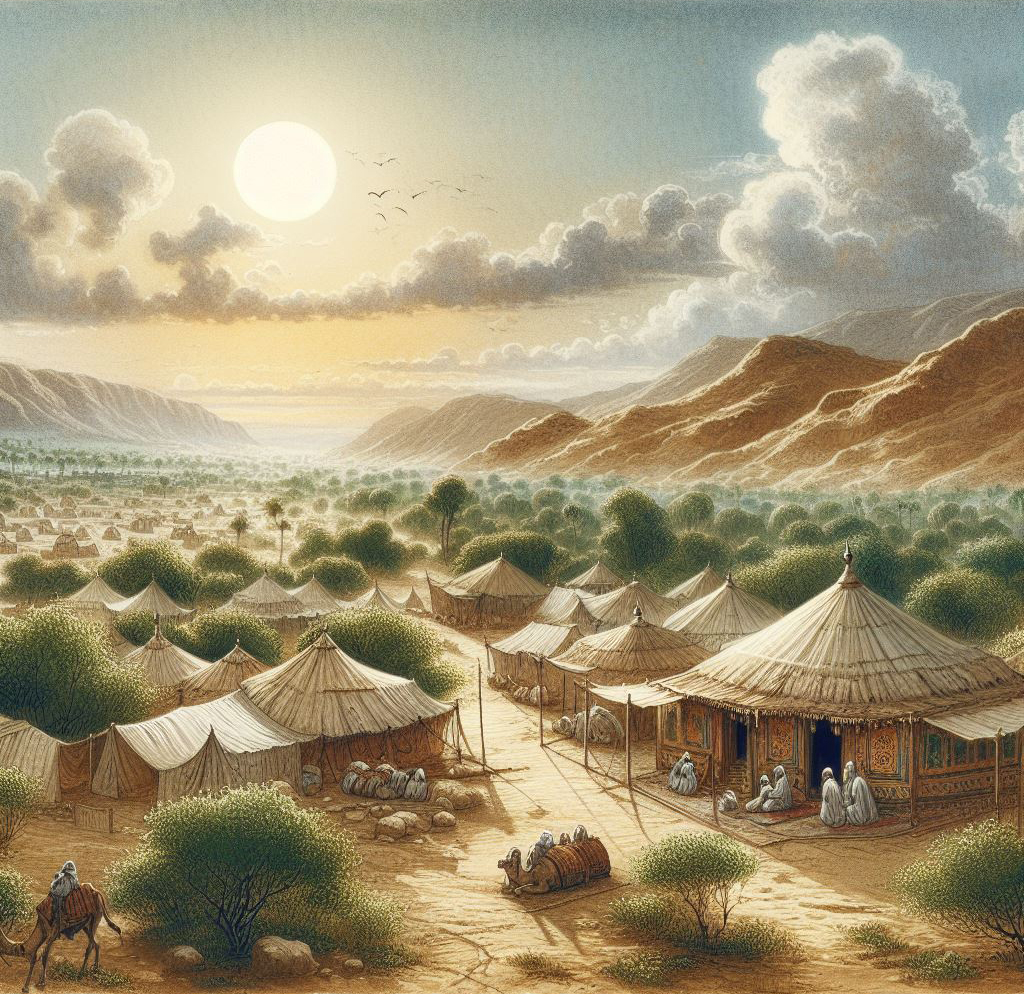
Every Ortagui-related Camp, Band, and Garden had been scattered over northern Midgard’s lush soils. Growing in numbers, they created new places for themselves or seized camps that others had constructed. The Ortagui flourished in woods and farmlands, rivers and lakes, and communities ranging from camps to cities. In 56, they encountered Clovincaz to the east for the first time in the world; in 58, they met Findograa to the west; and in 61, some Moss'Ari emerged from the wilderness. Throughout the years, decades, and centuries that followed, many more of these were encountered. They also encountered Drakk Alfar in 64, Ljost Alfar in 67, Kobold in 69, as well as Fautyr in 71.
The Ortagui were successful in establishing multiple villages, towns, and cities throughout the region. Local products were thriving, business in their area was brisk, and luxury goods arrived from far and wide. They created a wide network of routes connecting their trade centres with the help of their neighbours. From Staria in the south to Keshon harbours in the west, to Puchaxa in the east. In order to protect communities and caravans from bandits and Fautyr, they devised quick-light cavalry with schimitars and arrow-shooting archers.
Why a few Ortagui camps at Findon were dropped in 134 remains a mystery, especially given how seldom the Ortagui engage in mana manipulation. Perhaps it was their devotion to the Earthnodes who did not become gods.
A few Ortagui camps had also been flung far from the others in our known world, becoming part of indigenous life in southern Mealis. Located along the coasts of what are now the countries of Pearlin, Burfal, Zanzati, Meneya, and Thang. They began trading with their Findograa neighbours, and in 162, they reached out to the other Ortagui of Midgard.
During the First Age, when Ughuz appeared in 2942, many Ortagui Clans migrated northward, and some even sailed to their relatives at Mealis.
In 2949, some of the Ortagui who lived in today’s Thayri, Puchaxa, Goldar, Zilbur, Xothros, and —began to move away owing to Clowincaz. Leaving behind a relatively isolated Ortagui community in Goldar, which continued to trade with those of their kin, as well as the distant colonies at Findon and all the short treks across the now-lost islands all the way to Markeoy, The Goldars have developed to be a nautical people, considerably more so than their mainland counterparts.
Skjald Yell'a'Beard
The Tribes of Ughuz
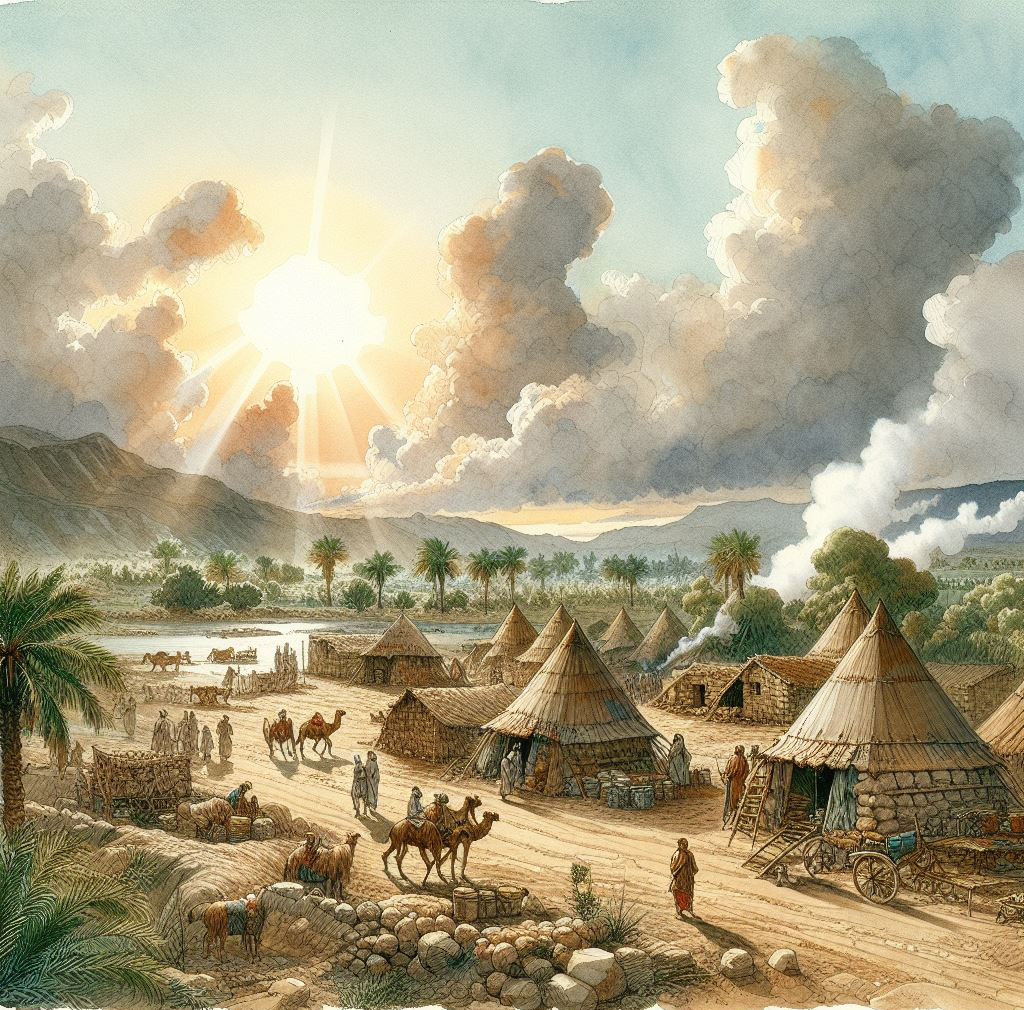
In 2942, everything was going well, but it turned out to be a dreadful year for the southern Ortagui, as a flood of Ughuz surged into Staria from the mountains to the south. Attempts to keep these war-hardened exiles at bay failed because they brought gunpowder and flame weapons, and they entrenched, multiplied, and spread like flames on stormy steppes.
In 2945, Starias, southern Ortagui, had been defeated by the Ughuz and began to flee as the Ughuz spread. The Findograa to the west and Clovincaz to the east at first felt refugee pressure, but then they also experienced the Ughuz as the Ughuz marched on. Even Fautyr, Kobold, Drakk, and Ljostalfar had to make way. There’s also a tale about Wickeryadi being blown up and burned, but that’s some crazy talk.
Thus, the Ughuz web gradually grew intertwined with Ortagui, and in 3094, savvy Ortagui managed to gain the secrets of Explosive Powder. This resulted in some amazing battle vehicles and a great number of guns. But never to the same extent as the Ughuz, since the Ortagui were too attached to their horses, schimitars, and missiles.
Seeing their neighbours thrive in physical disciplines, they concentrated their efforts on becoming great masters of alchemy and blacksmithing. The skill of voidwowen pattern-steel swords was one of their best crafts. Kootz steel ingots obtained from Kobold smith families in Irs Aknal or Nasarohk were used to make the blades. The blades were subsequently honed and hammered into the most intricately designed blades, which were thought to hold essential Truename syllables in their pattern. As a result, their blades are distinguished through various banding and mottling patterns. These blades are robust, resistant to breaking, and can be polished to a razor-sharp, durable edge.
In 3471, a great plague struck the Ortagui; sadly, it was one that took a while to show, so it spread throughout their entire population, hitting traders the hardest. Thus, 214 of their most skilled swordsmiths died, as good as eradicating this ability. While bladecraft has long been gone, alchemy was not, and Ortagui continually improved their talents and produced several new metal mixtures, powders, fluids, potions, and the like. Which they sold in huge quantities to anybody willing to pay the asking price, making them a sought-out aspect of life in Midgard’s northern steppes.
Skjald Sigurd
The earth shifted

3967… during the year of the 1st Cataclysm… the mountain ranges in south Staria rose dramatically..
And the praised Thursar Twins… experienced a dramatic metamorphosis…
No longer drifting down south.. but springing forth, soar across the sky… and set in the north…
Both are now much closer… than previously… searing the northern regions… from burning Sun.
Skjald Kazumix
Second Age
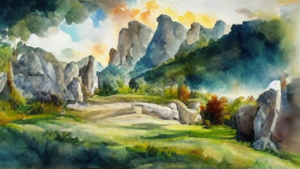
Recovering from the caraclysm, the Findon Tribes began to dwell in nomadic tent-villages or clay-towns in the sandy dunes, close to their Thursar Sun god. They engage in weird rites praising their master. They are good friends with Kobold and Drakk Alfar and are skilled at weapon making. As Voidweave Pattern Steel swords again appeared on the market in 135, some say they still know how to make them.
Mealis lost a lot of territory, and numerous clans got swallowed up by the sea. Making the already overcrowded Isle’s communities even more populous, as the deserts and wildness are typically too hot to live in.
The vast majority of the Midgard-Markeoy linking isles and long-stretching peninsulas sank.
The northern lands eventually dried up, leaving nothing but desolate sand dunes. Travellers’ flesh burned throughout the day, while the nighttime cold stiffened their bodies. And there were tales of ‘No light sky’ days, when the void during the unusual weather leaked energies into our world. The first is said to have occurred in 148. The Ortagui way of life gradually altered as the northern areas dried out and sea routes vanished. They became significantly more nomadic, lost confidence in the few gods they had previously praised, and almost all turned towards the Sun and Moon. The only deities they had known and yet trusted, despite burning their lands—a trivial test of their faith and a life imitating their ‘God’s sacrifice.
169, words spread that the once-mighty Drakk and Ljost Alfar were now traversing our world as vampires. This story of extraordinarily powerful beings, capable of defeating beasts and whole hunting teams with a few claw slashes or weapon swings, unfolded gradually. Rumours about these human prey hunters arose, frightening both rural and urban residents. As stories of blood-drained victims continued to arrive in increasing numbers, it became clear to the Ortagui chiefs that it was more than talk.
In 194, they established the first academy of vampire studies. The academy staff began to identify vampires who were caught and slain. But it only drained humans from recent vampire generations, never those of the first ones. In 246, along with the stories, people began to isolate. Towns, cities, and rural tribes gradually grew apart. Because of the isolation, clan pride became a major trait, and cross-community marriages grew less common until they were almost non-existent. As a result, various Ortagui groups began to differ in appearance and culture. Nonetheless, they continued to trade and join forces against external foes.
628 The ‘Dunelords War’ erupted as a result of the thirst for domination among the Ussain, Timurq, and Higzi tribes. It descended as a stormy fire from the steppes on the tribes and clans, and by 629, both Findograa and Clovincaz had been pulled into the conflict. Drakk Alfar, Fautyr, and Kobold got engaged in early 630. And in 631, Ljost Alfar felt the lands’ fires. The Ussains ultimately surrendered in 635, and their whole tribe caved in, leaving only the scattered remnants of once-mighty clans. Until the late 1930s, the N-Erectus were able to force the Ortagui to fight exclusively amongst themselves, while Tatongol and Clovincaz were able to protect boundaries and freeze frontiers. Thus, only the Timurq and Higzi tribes, together with their Ortagui allies, fought for control.
As a result of having lost easy access to Markeoy from Goldar in the 1st Cataclysm, only a few Ortagui fled from the ‘Dunelords War. Almost the same counted for Findon and Mealis, which had lost lots of land, So, those fleeing from the ‘Dunelords battle’ to the colonies, which had remained neutral throughout the fight, ended up further crowding already packed settlements.
644 became a turning point year for the Higzi as bizarre pig-faced associates poured onto the battlefields, disregarding arrows and mocking schimitar cuts. Almost turning the conflict in their favour, these new allies attacked and murdered a Thursar, which had the unintended consequence of other Thursar, and all N-Erectus save Drakk Alfar, joining the fight and aligning with the Timurq Tribes. It is reported that all of these allied pig-heads and the Higzi were murdered. Ljost Alfar and Thursar, who were present during the conflict, confirmed that the pigheaded were actually Pigryn.
In 645, as a result of the Timurq Tribes’ victory in the ‘Dunelords War, they claimed sovereignty over all Ortagui territory and chose Chieftain Mözû Ghân as the ‘Grand Mufta of the Ortagui ‘Lifkafate. Stretching from Keshon in the west, along Midgard’s northern shores, to Mt. Lipamo and Mt. Kazumi in the east, bordering the Clovincaz Empire in Puchaxa, and down to Starias southern mountain border at Obmil Ridge. This first Ortagui empire would stand for a millennium.
1372 An army of Fautyr, Moss’Ari, and Clovincaz attacked their eastern boundaries this year. All Ortagui tribes quickly reached out to all clans, and they rallied behind the banner of “Celestial Winds.”
1538 was another memorable year, when the Ortagui Clans sent their best throughout their borders, banding together to rid the wilderness of monsters.
1728 A year marked by torrential rains that flooded every river, stream, lake, and oasis. Cities, towns, villages, and farmsteads were submerged for weeks before the layers of mud began to drift away on their own as everything dried out. No water for months, no harvests in the summer and autumn, and then a major epidemic came forth. Every place was forced to bar doors and gates, and organised supplies were assaulted and dispersed. Civil turmoil eventually erupted in a single year. The ‘Grand Mufta was assassinated and impaled, dividing the ‘Lifkafate into four kingdoms.
1729: After a thousand years of recuperation, the Ûssain was the first tribe to assemble their own and some neighbouring clans into “The Southern Kingdom.” They had a lot to give and build on, especially considering they were the masterminds behind the supply looting.
1730 saw the formation of both the ‘East-Central Lifkafate’ and the ‘North Azųrgią’ kingdoms.
1731, finally the ‘West-Wind Ortagii’ hoisted their flags.
These four kingdoms spent the next 829 years fortifying their bases, safeguarding their people, and raiding each other at the frontiers with public-funded pirate and robber bands.
In 2560, ‘West-Wind Ortagii and ‘North Azųrgią agreed on a permanent boundary, and their borders witnessed peace and prosperity for the first time. All the pirates, thieves, highwaymen, rascals, and whatever else they called themselves that could be found were enlisted in an army moving south towards “The Southern Kingdom.”
As ‘The Southern Kingdom moved their army to receive the approaching onslaught from the north, depleting its rural fortifications,’ East-Central Lifkafate dispatched a big cavalry force to its neighbour. When the north-marching defenders learned of the side/rear onslaught, despair erupted, and their marching columns and formations disintegrated. Some abandoned their weapons, others ran, and some even began to infight. Commanders were unable to restore order, and as a result, the northern invaders drove through them a few days later, and they were defeated. Many lives were spared because they surrendered when they encountered opponents. As a result, regular people in the erstwhile ‘The Southern Kingdom’ experienced peace in 2561. But their 800-year-old country and its aristocratic family were no more.
‘West-Wind Ortagii and ‘North Azųrgią both had a fair share of ‘The Southern Kingdom, but both were disappointed by the amount ‘East-Central Lifkafate took. So, in 2563, they started planning how to get things straightened up, taking what should have been theirs. Oh, if only the ‘North Azųrgią had the ability to look into the future, or at least into the tents of the ‘West-Wind Ortagii and ‘East-Central Lifkafate leaders’ lengthy conversations. They would have been prepared for the impending storm.
2581 The Clans of ‘West-Wind Ortagii marched eastward to provide assistance for the North Azųrgią’s vanguard move into the ‘East-Central Lifkafate,’ but the North Azųrgią was caught off guard. As they prepared to meet ‘East-Central Lifkafate’s army, word arrived from the rear that ‘West-Wind Ortagii had assaulted their garrisons, killing guards and militia and looting supplies. A crushing strike that caused their army to disintegrate. North Azųrgią had crumbled and ceased to exist within a year of being partitioned between ‘West-Wind Ortagii and ‘East-Central Lifkafate. Over the following 740 years, these two larger tribal coalitions fought to outmanoeuvre each other.
In 3021, ‘East-Central Lifkafate crumbled, and ‘West-Wind Ortagii seized wide swaths of country, although numerous eastern and southern tribes fought with the assistance of Ughuz, Tatongol, and Clovincaz.
Skjald Ulrich
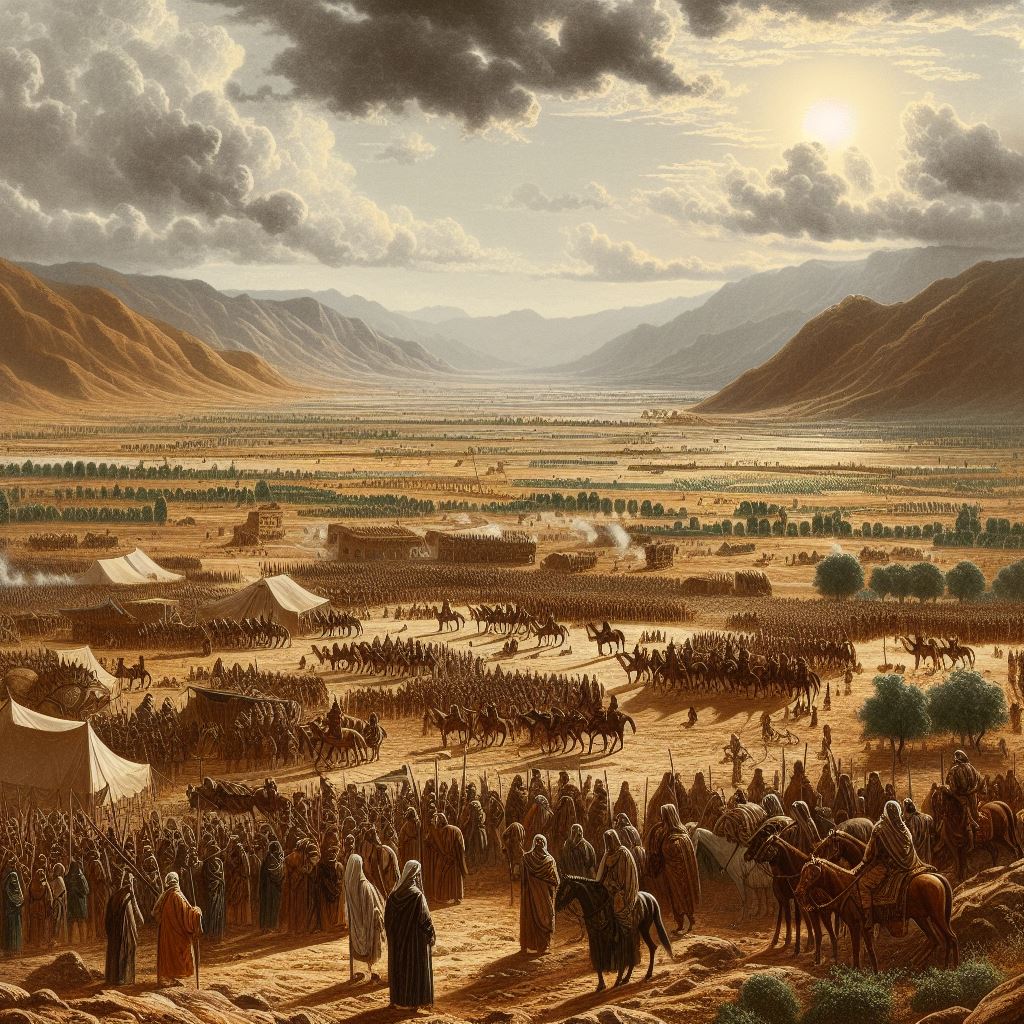
In 3351, the ancient Ortagui kingdom was finally fully reunited as the final recalcitrant tribe surrendered. The leaders resurrected a 2706-year-old title and named Ögžlųm Źhirą ‘Grand Mufta of the Ortagui ‘Lifkafate. And they tried their best to grow and evolve, despite various clans and tribes attempting to destabilise the ‘Grand Mufta,’ culminating in rebellions that were ruthlessly suppressed. But the fire in Ortagui is raging, and strain is mounting on the massive framework.
In 3607, the Ortagui empire fell for the second time, this time severely fracturing multiple tribes, leaving most clans standing or roaming without links or alliances.
In 4020, after more than 400 years of every clan for themselves, an attempt was made to restore former glory when the Ųgmųz, Yâgül, and Nomilų clans united to form a new tribe, Ųgülų. It was time for treaties, weddings, and commerce. It was a lengthy process, but clans began to reunite and links began to strengthen once more. The only battles happened when they attempted to retake territory taken or inhabited by the Findograa, Clovincaz, Tatongol, Ughuz, and N-Erectus. These external foes served as another unifying force, and the Ortagui vision of a Lifkafate rebirth emerged.
4342 It was the year in which the first vampires were slaughtered. When a T’Aurs-like human marched through their capital’s main plaza with an authority few would possess, It strolled up to an inn’s outdoor lot and confronted a visitor sitting in a high-collar robe with a broad-rimmed hat in the inn’s cooling, half-hiding shade. As the T’Aur-like approached, the visitor twisted its head and peered up, then sprang up and sliced forth a long, nailed, pale hand, missing the opponent’s face by a hair. People in the capital witnessed the power, agility, and speed of vampires in a vicious struggle that no mortal Ortagui could survive. Furniture, construction parts, and unfortunate bypassers were subsequently hurled everywhere. The bullheaded one grabbed the Vampired head and instantly squashed it to the size of an apple. Looking around, the bullheaded victor dropped the mess, licked his lips, dried blood and gore off in the vampire’s coat, picked something off the body, and strolled out of the capital unchallenged. The city guard swiftly gathered the vampire body parts and provided them to the academy.
Skjald Valgrif
Third Age
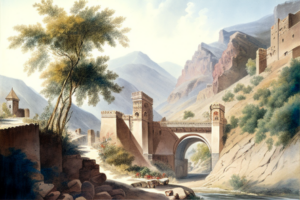
Following the event in their capital’s plaza, they learned about The Crossing, a vast number of Wanderers crossing the mountains far to the south. These Wanderers of the Crossing migrated to Ortagui coasts or journeyed inlands for the following 360 years while settling down. Some of the very early individuals were searching for a bullheaded god. Tensions over living space occasionally erupted into war, particularly with Vular colonies or strongholds. However, the Ortagui Clans gradually welcomed these intruders, either because they were viewed as useful assets or because they were simply too tough to eliminate. Marriages or run-offs did take place, resulting in mixed offspring.
361 A pact was negotiated between Ortagui and the Wanderers, in which the former acknowledged the latter’s settlements and the latter committed to cease growth. They promised they would eventually betray both of them.
In 853, Ortagui and Findograa assaulted and plundered the Vular village of Gnauti. The first of multiple confrontations in what became known as the “North Vular War.” As the battle progressed, it engulfed the entire north, including Mealis and Findon. As a result, numerous Wanderer and Indigenous communities were destroyed.
1173 The ‘North Vular War came to a conclusion when the Wanderers banded together to form the biggest force of their type ever. Putting past grudges aside, they fought with the fierce partisans, focusing on the Clans of the Ųgülų. They were able to shatter the burgeoning Lifkafate, weakening the Ortagui’s increasing cohesiveness. However, it resulted in significantly fewer but more powerful Wanderer communities, choosing long-distance commerce with their own kind above local relationships. The Ortagui spent the ensuing centuries gradually separating the communities.
Skjald Sigurd

1628 This year witnessed another clan unification as they cleansed territories of monsters.
2294 Mealis witnessed a massive inflow of Midgard Ortagui seeking to flee the ‘Findograa Harvest,’ as the fighting became known.
2294 A strong Findograa army was encountered and defeated on the southern banks of Nimabu Pond.
2518 As a strange Clovincaz King began swiftly extending his dominion, mayhem erupted. The force leaders were assassinated regardless of who was dispatched to confront the enemy. With the deaths of the leaders, the defensive forces dispersed, and the Clovincaz appeared unstoppable. Very few reports were returned, but the limited information began to reveal a pattern, and they realised they were dealing with a vampire.
2519: They devised a strategy while focusing on the vampire and therefore disregarding its troops. Finally, after a fierce battle between soldiers, they succeeded in having the vampires assault their command camp. It was confronted by a swarm of the most elite soldiers, vampire trappers, and monster hunters as it prepared to slay leaders. It was a terrible battle that cost dozens of the finest, but they managed to kill what is believed to be the very first second-generation vampire killed, owing to its power ability. When the vampire died, the vampire’s Clovincaz minions were defeated and driven back to their homelands.
2968 Another attempt to purge the Ughuz saw the light of day but failed horribly. And the first carnage was tenfold compensated. As a result, many Ortagui Clans perished, sparking a mutiny against the remaining gül, and with their annihilation, the Lifkafate restoration faded.
4230 The Vular began to stir in their colonies once more, although this time less forcefully and more diplomatically. However, as time progressed, particularly when significant sums were spent for ancient schimitars and whatever Kootz steel they could obtain, Ortagui commanders realised that all the Vular wanted were recipes for Voidweave Pattern Steel swords. After speaking with Kobold populations, they discovered Vular had already purchased tonnes of Kootz ingots. Fearing another Wanderer storm, they readied themselves and did everything they could to keep the lost recipes from falling into Vular hands.
4286, suddenly, the sky to the south greyed, then darkened, and then a thousand different hues flickered and glittered. Colourful lashes are being sent hundreds of kilometres north. It was Mt.Vula erupting, followed by Ljostari sinking, sending a shockwave across our world in the shape of the Deep Blue Tsunami.
The Findon Ortagui were never fond of the Ortagui who relocated there, and even after generations, they see these descendants as undeserving of genuine trust or marriage. Those who escaped the ‘Dunelords War’ are especially distrusted, despite the fact that they are all in high demand as labourers.
Several Ortagui communities on Markeoy regarded Wanderers as reinforcements against the Markian people, and they coexisted happily.
Skjald Vinotis
Fourth Age
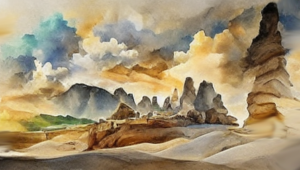
In 1, the Deep Blue Tsunami just brushed the coastlines of Ortagui lands in the far northeast. However, there was no immediate damage. Mealis totally escaped the Deep Blue Tsunami.
In 5, as the land had calmed down south after the calamity and the tsunami was becoming a distant memory, word circulated about two Arisen settlements on the eastern coastlines. Led by two Arisen Tomb Kings, Agnül Zhadim, a former Ortagui king, and Aiximâ Hizûxômi, a former Clovincaz king. Both caused significant upheaval as their domains expanded, and they revived long-dead relatives and buried corpses to bolster their ranks. Eventually, a living coalition emerged, and they marched to face the Arisen. Because the Arisen had not yet realised their true nature and potential, forebears and descendants reached an agreement, and their spread was halted.
All races gradually became acclimated to the returning dead, and both camps coexisted in relative harmony. In actuality, there was greater conflict between Ortagui and other living humans, as well as the Fautyr. The former is lusting after the same locations and resources, and the latter is unwilling to see more communities destroy nature.
Only those who came after being pushed out by Arisen were accepted as real relatives, as the Ortagui of Findon are fully aware of Arisen. When the Deep Blue Tsunami struck, three colonies of Ortagui Arisen arose, and four Ortagui transformed into Liches. So they battled them fiercely, and a tenuous ceasefire was ultimately struck in 59.
Despite the fact that Markeoy’s coastal Ortagui colonies were severely damaged, a large number of survivors from Goldar’s eastern half arrived since their small island and coastal towns had been swept away. And growing instability as a result of the Arisen, who are fighting not just the living but also rekindling millennia-old wars.
Skjald Sejrik
Ortagui’s First Lich Priestking
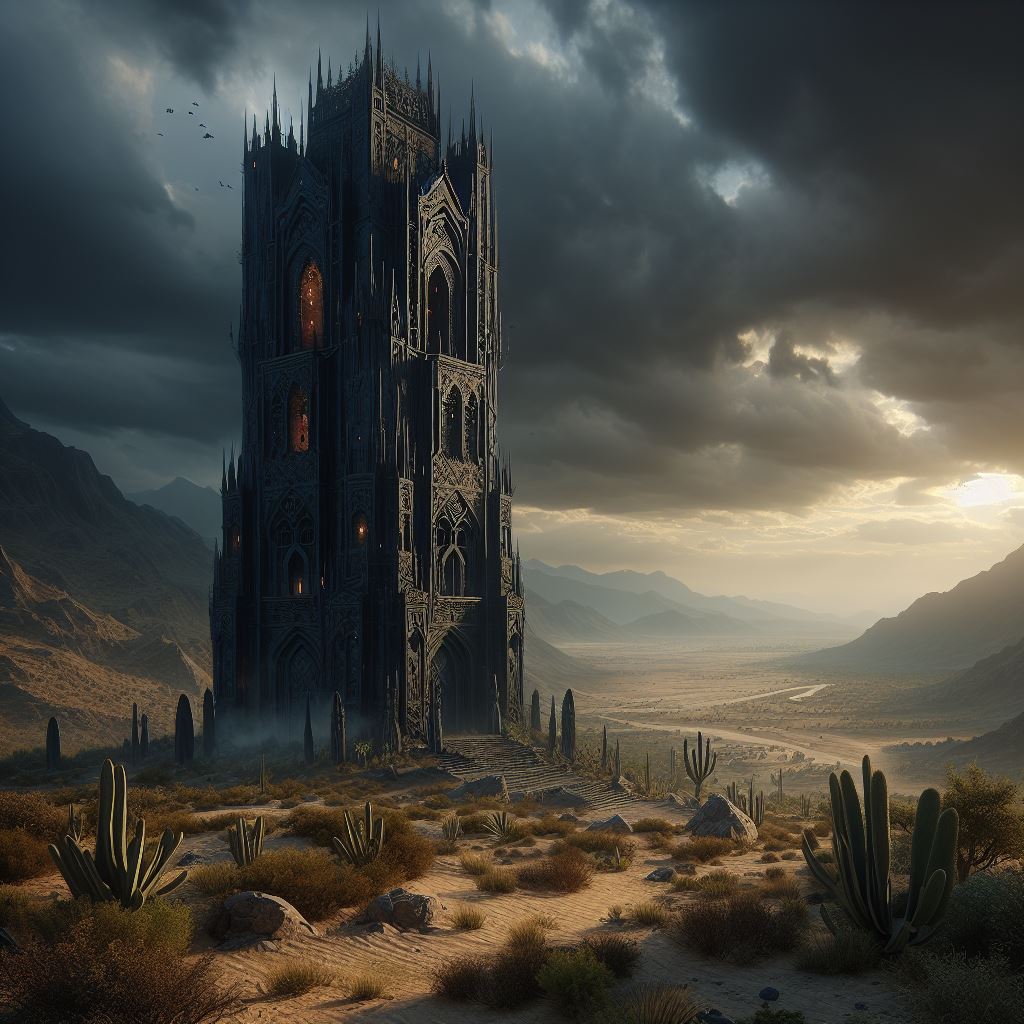
In 724, Erdiga Simök, a Scholar and seeker of arcane knowledge, executed an old ritual in this year, and so became the first Ortagui Arisen Lich Priest-King. He created Kza'noobo Kiznoll, a realm wrapped in mystery and wickedness.
Kza’noobo Kiznoll’s influence spread to the neighbouring peoples. The Kobolds to the north felt a disturbance in the balance of magic. The development of Kza’noobo Kiznoll had an equivalent impact on the Ughuz and Tatongol peoples to the south. Kza’noobo Kiznoll stirred intrigue and dread among the remote communities of the Drakk Alfar, Ljost Alfar, Moss’Ari, and Fautyr. The influence of Kza’noobo Kiznoll’s narrative grew well beyond its limits as it unfolded. He offered no quarter when envoys arrived to negotiate a halt to his growth, far more conscious of his capabilities than the rather bewildered tomb Arisen long before. Not until he was told that if he didn’t contain himself, he’d have numerous unwanted guests, even from tomb Arisen. As a consequence, traders and caravans started to avoid Kza’noobo Kiznoll, and many neighbouring rest stations, communities, and villages were eventually abandoned.
Skjald Ulrich
Ortagui’s First Lich Priestqueen

In 942, a tale of power and transformation echoed through the land. It was about Özlen Ergû. a remarkable Ortagui Mana Manipulator who was driven by a desire to achieve immortality, Özlen embarked on a path towards the coveted title of the first ever female Arisen Lich Priest Queen. Performing an ancient twisted ritual and the blood-infused, tainted waters of the Deep Blue Tsunami, she became the first female Arisen Lich Priestqueen. Özlen’s realm became woven into the very rocks of Keshon’s western shores, overlooking Lake Karraq, in the borderlands between Flurg and Keshon. The influence of Zlen’s realm spread, reaching the shores of Lake Karraq and beyond. The nomadic people who had once traversed these arid lands grew dissatisfied. And the N-Erectus’ enclaves felt the impact of Zlen’s realm in various ways. Her realm gradually depopulated the coastal areas and nearby settlements, causing caravans to avoid the area and seek alternate routes.
Skjald Vinotis
1168 was the first time agents from the 1st Alliance approached Ortagui Clans, and Black Oak soon began to visit Clan leaders on a more regular basis. Several Ortagui Clans saw this as an opportunity to strengthen their positions, rid themselves of old foes, and utilise it as a tool to weaken Ughuz, Tatongol, Findograa, Clovincaz, Wanderer, and Common influence over their ancestral lands. So many people threw themselves wholeheartedly behind the Alliance and fought alongside the High King in the final battles of 1149. Others knew that The Realm and a distant High King, most likely of Wanderer blood, would mean more administration and foreign laws, so they remained strongly opposed.
Skjald Sigurd
In 1250, as the alliance behind The Realm had triumphed the previous year, rewards and pardons were given and punishments were carried out, causing the ripples some had hoped for. Clans of the leading tribes began their “Game of Two Faces,” sending numerous envoys and diplomats to the realm capitol Grimsborg south of the mountains, both infiltrating the great court and spying on distant and nearby races. And as informants aimed at bolstering Ortagui’s dominance north of the mountains, They soon discovered that Ughuz and the N-Erectus were doing the same thing, so they upped the ante.
Skjald El Mary
In 1277, came The Great Invasion, and the Ortagui realised they were up against foes greater and more dangerous than their neighbours and N-Erectus, including High Kings, Arisen, and malicious ods. As a result, very few clans were neutral towards the invaders, and it was a rare clan that followed their leaders’ lead and supported the invaders. Thus, there were few internal Ortagui clashes between 1277 and 1282, but as they sided with The Realm’s alliance, they suffered terrible losses in defeating invading Pigryn, Anurai, Kinoblin, and treacherous Drakk Alfar.
1282: Many clan leaders swore the oath and joined the Cleansing Crusade, and their rash demeanour frequently resulted in them taking the initial force of clashes, resulting in many deaths by the time the crusade ended in 1283.
Skjald Sigurd
Cartography

They are the tribes of north Midgard, spread throughout the following Isles and Countries
Midgard: Flurg, Goldar, Keshon, Shoak, Staria
Skjald Ulrich
Organisation
The saviour family respects, but generally values, the wisdom of age over family ties. As a result, they can adhere to their strong clans or tribes while also following the advice of a non-related elder. Especially if the elder’s position is associated with high social standing. This system extends all the way up to their nobility, ensuring the obedience of princes, princesses, kalifs, and their Mufta.
Skjald Yell’a’Beard
Special
Aside from the occasional praise of whichever deity they believe best fits their daily workings in order to make the most of their relatively short lifespan. They sing the great Thursar’s praises as they sail the sky as the Sun.
Skjald Valgrif
The most famous of all these are without doubt Setil
Skjald Sigurd
Last Updated on 2024-03-13 by IoM-Christian
